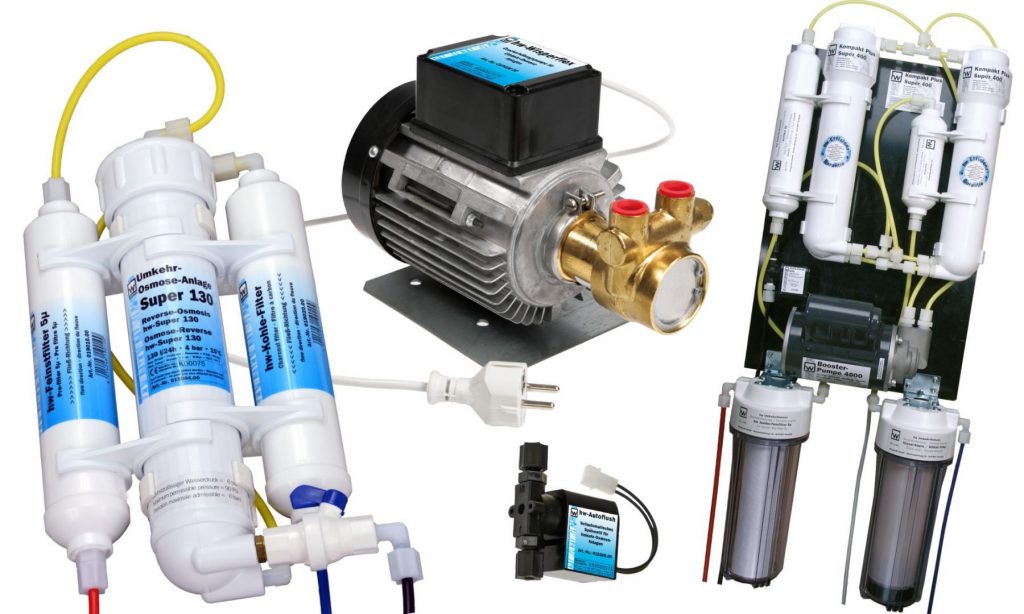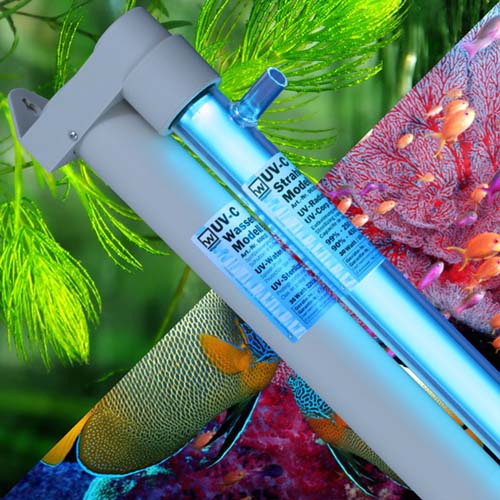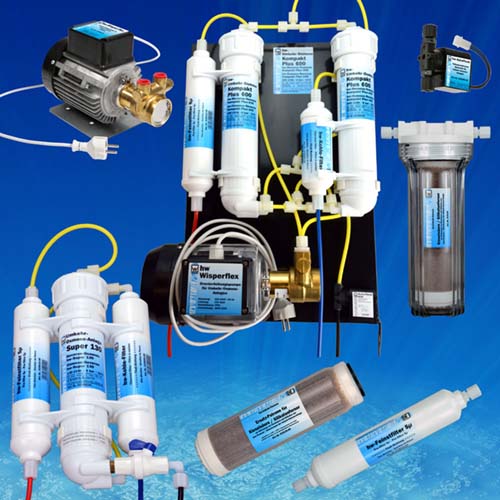Water treatment with hw® reverse osmosis units
Tap water is not an optimal aquarium water. It usually contains impurities such as Chlorine, nitrates and various heavy metals. There may also be residues of various pesticides. These small amounts are still relatively harmless to humans, but these contaminations can cause the greatest damage to our extremely sensitive aquarium inhabitants. Reverse osmosis systems offer the most economical and at the same time the most efficient method for obtaining the purest and softest water for marine and freshwater aquariums.
hw® reverse osmosis units:
The most modern, environmentally friendly and effective method of water treatment.

The ion exchangers:
Most ion exchanger-based water treatment systems on the market replace hardness-forming ions (e.g. calcium) with other ions (e.g. sodium). This creates a shift in the ion ratio, which leads to unforeseeable consequences in the aquarium. In addition, such systems must be regularly regenerated with chemicals.
Reverse osmosis process:
In contrast, the hw reverse osmosis is a natural and environmentally friendly process in which the dissolved salts and pollutants are safely removed from the water by purely physical means. With the hw® reverse osmosis, the water from the house supply (water pressure 2 to approx. 6 bar) is pressed against a semipermeable (semi-permeable) membrane. In this process, only the water can diffuse through the membrane. The retained, dissolved substances are drained off together with the residual water (concentrate).
The water obtained in this way is ultrapure water (permeate) and, except for the smallest, hardly detectable traces, free of harmful contaminants, such as. B. chlorine and hardness, since the majority of the substances dissolved in tap water can not penetrate the membrane. The ratio of ultrapure water to residual water is approx. 1 to 3.5 – 4. This ratio becomes more favorable the higher the line pressure and the temperature of the water (see table above). The relatively high proportion of residual water is indispensable with this principle, because the concentrate ensures that the substances removed from the permeate are removed and at the same time cleans the membrane, the fine pores of which would quickly clog up without sufficient flow. The remaining water can also be safely used as process water (e.g. cleaning or toilet water). The ultrapure water obtained is taken from the device via a separate pipe. Depending on the initial water, its pH is more or less in the slightly acidic range. In order to obtain ideal aquarium water, the often pure distillate-like osmosis ultrapure water should be enriched with trace and bio elements. The hw liquid preparations for sea and fresh water are particularly suitable for this. hw® sea salt is also specially adapted to the use of ultrapure water from reverse osmosis systems.
The unsurpassed advantages of the hw® reverse osmosis systems:
Extreme durability thanks to the use of the unique “hw® polyvinyl membrane”. The quality and performance of a reverse osmosis system primarily depend on the quality of the membrane used.
hw® reverse osmosis systems are equipped with the unique “hw® polyvinyl membrane”. This membrane consists of a fully synthetic material developed exclusively for hw®. This membrane outranges the conventional membrane types like Acetate, triacetate or polysulfone membranes, in durability and performance. This means that the “hw® polyvinyl membrane” cannot be attacked or destroyed by bacteria, even if it has been disconected for several weeks (up to 3 months!). In contrast to the frequently used polysulfone membranes, the “hw polyvinyl membrane” is also largely insensitive to chlorine in tap water. We do not use polysulfone membranes in hw® reverse osmosis systems, primarily because of their sensitivity to chlorine and their poorer performance ratio (permeate to concentrate).
As also the best chlorine resistance has his limits when reaching extreme chlorine concentrations (such as the practice of so called “shock chlorination’s” of many southern European waterworks), we equip all hw® reverse osmosis devices (model series “Super”) despite of their chlorine insensitivity Membranes with upstream carbon filters. The membranes in hw® reverse osmosis systems tolerate a total salinity up to 2,000 mg per liter and are insensitive to carbonate hardness up to 22 ° dKH. Our membranes are completely insensitive to pH values from pH 3 to pH 10 and are suitable for raw water hardness up to max. 30 ° dGH.
hw® service and guarantee:
All hw reverse osmosis systems undergo a special 24-hour function test before delivery, during which the performance of the respective system is checked and documented up to the maximum load. We also provide a 18 (!) Month guarantee on all hw® reverse osmosis systems. Should maintenance or repairs become necessary in the course of time, we will carry them out within 48 hours (on working days, plus post).
A detailed repair report with the performance data of your device is included free of charge.




